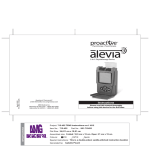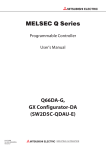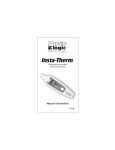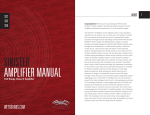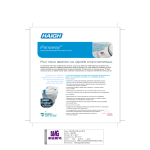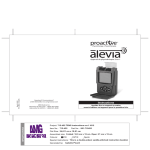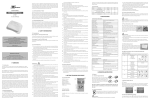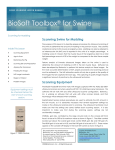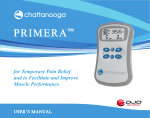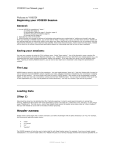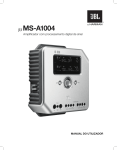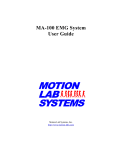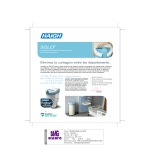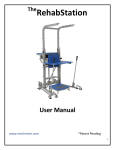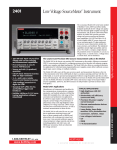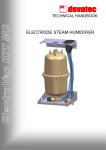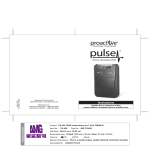Download Instruction manual (pdf file)
Transcript
Physiotherapy • Physiothérapie Rev1 0812 P/N 861-715430 3-in-1 Physiotherapy Device Questions? Comments? 1-800-363-2381 www.amgmedical.com Instructions AMG Medical Inc. Montréal, QC H4T 1V5 • 1-800-363-2381 Alpharetta, GA 30022 • 1-866-321-4846 Please read this manual thoroughly before using this device for the first time. 715-430 TENS instructions rev1 1012 715-430 861-715430 24,811 cm x 18,81 cm Folded: 10,5 cm x 15 cm. Open: 21 cm x 15 cm TM This is a double-sided, saddle-stitched instruction booklet. Véronique Descormiers TABLE OF CONTENTS INTRODUCTION..................................................................................... 3 • What is pain? • How does TENS work? • What is EMS and how does it work? SAFETY INFORMATION ........................................................................ 4 • Indication for use • Contraindication • Warning • Precautions • Adverse reactions DEVICE OVERVIEW ............................................................................... 5 • Components and parts • Display symbols • Function keys INSTRUCTIONS FOR USE ..................................................................... 8 • Complete step-by-step PRE-SET PROGRAMS....................................................................... 12 • TENS programs • EMS programs • MASSAGE programs CLEANING AND MAINTENANCE ...................................................... 16 • Cleaning the device and accessories • Maintenance TROUBLESHOOTING ........................................................................ 18 STORAGE .......................................................................................... 19 WARRANTY ...................................................................................... 20 TECHNICAL INFORMATION.............................................................. 20 ELECTRODE PLACEMENT GUIDE .................................................... 21 2 INTRODUCTION This device can be used for pain relief, muscle stimulation and massage. It provides two independent, controllable output channels. A pair of electrodes which can be connected to each output channel and the current's parameters and intensity level can be adjusted according to your needs. 1. What is pain? Pain warns our body of injury to prevent additional damage. This sensation is important because without it, vital parts of our bodies might be injured without our knowledge. However, long-lasting, persistent (chronic) pain, once diagnosed serves no apparent purpose and reduces quality of life. 2. How does TENS work? TENS (Transcutaneous Electrical Nerve Stimulation) refers to the transmission of small electrical pulses through the skin to the underlying peripheral nerves. The theory of TENS suggests two different modes of operation: In conventional (high frequency) TENS, continuous mild electrical activity may block the pain signal traveling to the brain. If the pain signal does not get through to the brain, the pain is not “felt”. In low frequency TENS, short bursts of electrical activity may stimulate the release of endorphins, the body's own pain-control substance. Ask your physician or therapist for more details. No matter what pain theory is used, TENS has been proven useful in pain management for many patients in helping to make their lives better. 3. What is EMS and how does it work? In normal muscular activity, the central and peripheral nervous systems transmit electrical signals to the muscles, making them contract. EMS (Electrical muscle stimulation) uses an external source (the stimulator, via wires and electrodes) to achieve the same effect, creating involuntary muscle contractions. This can help improve and maintain muscle tone without actual physical activity and therefore prevent atrophy. 3 SAFETY INFORMATION 1. This device is recommended for: • Symptomatic relief of chronic intractable pain, acute post traumatic pain or acute post surgical pain • Improving local blood circulation • Relief from muscle spasms • Immediate post-surgical stimulation of muscles to prevent venous thrombosis • Prevention or retardation of disuse atrophy • Maintaining or increasing range of motion 2. Do not use in the following situations: Undiagnosed pain syndromes (until etiology is established). • Cancerous lesions that are present in the treatment area. • Swollen, infected, inflamed areas or skin eruptions (e.g. phlebitis, thrombophlebitis, varicose veins, etc.). • Demand type implanted pacemaker or defibrillator. • Epilepsy • Serious arterial circulatory problems in the lower limbs • Abdominal or inguinal hernia • Safety has not been established for use during pregnancy. WARNING For external use only. The long-term effects of frequent electrical stimulation are unknown. This device should be used only under the continued supervision of a licensed medical practitioner. Do not apply stimulation over the thyroid or carotid sinus regions, as this could disrupt breathing, cardiac frequency or blood pressure. Do not use while connected to high-frequency surgical equipment or near shortwave or microwave therapy equipment. Never use in environments with high humidity (ex.: bathroom). Never place the electrodes anywhere on the front of the thorax or transthoracically as it can increase the risk of ventricular fibrillation, cause cardiac arrhythmia and lead to cardiac arrest. Never use near the eyes, the genitals, the heart or on areas which lack normal sensation. This stimulator should never be used by patients who are noncompliant or are emotionally, cognitively or mentally impaired. Keep the stimulator out of reach of children. 4 4. Precautions • Do not adjust controls while operating machinery or vehicles. • Turn the stimulator off before applying or removing electrodes. • Only use with ProActiveTM lead wires and electrodes. • Long-term stimulation at the same electrode site may cause skin irritation. Use only as prescribed by a physician. • Never use in rooms where aerosols (sprays) are used or pure oxygen is being administered. Do not use it near highly flammable substances, gases or explosives. • Apply the electrodes to clean, dry, and unbroken skin only. • Keep electrodes separate during treatment. Electrodes coming in contact with each other could result in improper stimulation or skin burns. 5. Possible adverse reactions Skin irritation or electrode burn under the electrodes. Allergic skin reaction to electrode gel may also occur. Display icons Therapy modes Therapy sites DEVICE OVERVIEW Front Top Back Pause indicator Intensity lock indicator Setting mode indicator LCD (see next page for display icons) Channel 1 Channel 2 lead wire lead wire socket socket Clip Low battery indicator Treatment time Pulse width and Pulse rate and channel 1 channel 2 output intensity output intensity Battery cover Keys (see page 7) 5 6 INSTRUCTIONS FOR USE Keys 1. Insert batteries Press and pull down on the battery cover to open. Insert 4xAAA batteries (included), matching the positive and negative ends of the battery to the markings, then close. 2. Connect electrodes to lead wires Insert the lead wire connector into the electrodes connector, ensuring that no bare metal remains exposed. • Turns the device on or off • In treatment mode, press to stop treatment • Use this key to exit memory or setting mode • Press to confirm user selection • In standby, press to select a treatment site or press and hold for 3 seconds to enter memory mode • In memory mode, press and hold for 3 seconds to clear memory data. • In user select mode, press to select a user (U1 or U2) • In memory mode, press to check data or confirm its deletion • In treatment mode, use to pause or resume • Increases / decreases the output intensity of channel 1 • In setting mode, press Ch1to select the next parameter • In standby, press to select a therapy mode • Increases / decreases the output intensity of channel 2 • In setting mode, press Ch2+ and Ch2- to ajust user program parameters • In standby, press P to select a therapy program • Press and hold P to enter setting mode 7 3. Connect lead wires to the device This device has 2 output channels, which can be used simultaneously (with 2 electrode pairs) or individually (1 channel with 1 electrode pair). After making sure that the device is turned off, insert the wire plugs into the sockets at the top of the unit. Caution: Always use the lead wires supplied with this unit. 4. Place electrodes on skin Ensure that the skin surface where the electrodes will be placed is clean and dry. Apply electrodes to the exact site indicated by your physician. The electrodes should be placed firmly and evenly on the skin to ensure good contact. See p.21 for our electrode placement guide, which also includes recommendations for stimulation positions. 8 Caution: • Always wash and dry the treatment area before applying the electrodes. • Do not turn the device on when the electrodes are not applied to the treatment area. Never adjust, reposition or remove the electrodes while the device is still on. •Always use this device with 4cm x 4cm self-adhesive square electrodes, or larger. 5. Turn the device on Carefully read the contraindications and safety information in this manual before using for the first time. Press . The device will first go into user select mode (see figure I). Select U1 or U2 by pressing and press S to continue. 6. Select the therapy mode and site Press M to select “TENS”, “MASSAGE” or “EMS”. The selected mode will flash (see figure II). Press S to select the therapy site (body part). The therapy site will flash once selected (see figure II). 7. Select the therapy program Press P to select the therapy program for the treatment site selected. The LCD will display program numbers (see figure II). See p.12 for details on preset and user-defined programs. 9 8. Adjust the intensity to start the treatment Press CH1+ or CH2+ to increase the output intensity of the corresponding channel, which will begin treatment. Use CH1- and CH2to decrease the intensity. The LCD will display the current output intensity (see figure III) and remaining treatment time. IMPORTANT • The intensity of stimulation may be adjusted as required to a maximum of 90 (1 level/step). • Always turn the unit off before removing the electrodes. • The safety lock feature automatically activates after 20 seconds of button inactivity. You cannot increase the output intensity while the indicator is displayed. Press CH1- or CH2- button to unlock the device. • The device stops automatically once treatment time reaches "0". • Press to stop treatment at any time and put the device in standby. Press the to simply pause treatment and press again to resume. If the device is locked, press CH1- or CH2first to unlock the device. • If an open circuit is detected on either channel and the amplitude level is 10mA or greater, the amplitude will be reset to 0mA. 9. Consulting the memory The device will record the treatment parameters (e.g. recording number, program, body part, the average intensity and treatment time) after you finished your treatment. The maximum number of records is 30, after which the oldest record will be deleted. To check the memory data, press and hold S 3 seconds to enter into memory mode. Press to read the memory parameter, and press CH1 button to read the next record when the LCD display memory number. 10 330 / Amplitude 200 modulated Simple Pulse rate 2 ~ 100 ~ modulated 300 modulated 40 200 pulse Simple 70 / 2 ~ 100 ~ modulated Hans 180 100 200 pulse Simple ~ modulated 200 Synchronous 280~ 100 200 pulse Alternate ramped 180 Continuous 80 200 burst 2 350 Asynchronous 50 KNEE 65 Synchronous 200 50 WRIST 70 ~ 180 80 80 FOOT 100 ~ 200 Pulse width modulated 2~ 60 ANKLE 12 2~ 8 / Amplitude 125 330 200 modulated Amplitude modulated Simple modulated pulse / 100 330 200 HIP 80 80 Continuous 180 2 ELBOW 80 180 80 / 2 BACK Hans 180 2 NECK Continuous 80 Simple 2 ~ 100 ~ modulated 200 Synchronous 125 200 pulse 70 ~ Pulse width 80 180 Continuous 180 modulated 70 ~ / Amplitude Hans 100 330 180 200 modulated Simple 70 ~ Pulse width 2 ~ 100 ~ modulated 180 modulated 125 200 pulse Simple modulated pulse 100 ~ 200 2~ 80 SHOULDER 50 Waveform Pulse Pulse rate width (Hz) (µs) Waveform P1 11 Program 1. Select the parameter First press CH1- to switch between the parameters to set (pulse rate, pulse width and treatment time). 2. Set each parameter Then, press CH2+ and CH2- to adjust. Press to confirm and go into standby, the use CH1+ and CH2+ to adjust the amplitude of each channel. NOTE: to change the parameters, press and hold P again. Waveform TO CREATE A CUSTOMIZED PROGRAM Turn on the device, select TENS or EMS and press P to select a user program. Once in U1, press and hold P to enter setting mode. In this mode, you can set the pulse width from 50 to 350µs, the pulse rate from 1 to 150 Hz and treatment time from 5 to 90 min. Therapy site 11. Low battery indicator When the indicator flashes, replace the batteries as soon as possible. However, the stimulator will continue to operate for several hours. P2 10. Turn the device off Press and hold to turn the device off. When not in treatment, it shuts off automatically 3 minutes after the last button operation. Pulse Pulse rate width (Hz) (µs) . U1 (Default) PRESET PROGRAMS IN TENS MODE Note: Treatment length for all options below is 30 minutes. Pulse Pulse rate width (Hz) (µs) Notes: • The device will return to standby when you press or after 30 seconds of inactivity. • To clear the memory: Press and hold S for 3 seconds. The number of records in memory will flash on screen. To delete, press . To cancel and return to standby, press 13 1 50 50 65 50 50 50 50 NECK BACK ELBOW HIP ANKLE FOOT WRIST KNEE Synchronous Synchronous Synchronous Synchronous Synchronous P1, P2, P3 P2, P3 P1, P2, P3, P4 P3, P4 P3, P4 P2, P3 P1, P2 Elbow Hip Ankle Foot Wrist Knee P2, P3, P4 Neck Back P1, P2, P3, P4 Shoulder P2 2~ 60 50 40 Synchronous Pulse rate modulated 350 350 Synchronous Synchronous P3 P2 P1 30 ~ 220 30 ~ 220 30 ~ 220 25 33 43 53 69 79 1 2 3 4 5 6 7 14 30 ~ 220 30 ~ 220 30 ~ 220 30 ~ 220 50 ~ 220 50 ~ 220 50 ~ 220 50 ~ 220 53 43 33 25 25 83 100 111 118 132 9 10 11 12 13 1 2 3 4 5 50 ~ 220 200 69 8 200 200 200 200 100 30 ~ 220 8 25 1 2.3 2.6 3.1 3.8 4 3.5 2.5 1.9 1.3 0.7 0.7 0.5 0.7 0.9 1.3 1.9 2.5 3.5 4 0.6 0.6 0.72 0.8 1 1 0.9 0.9 0.8 0.6 0.6 0.5 0.6 0.7 0.8 0.9 0.9 1.0 / rate Pulse width Work time Rest time Program Phase Pulse (Hz) (µs) (s) (s) 350 50 200 Asynchronous 300 2~ 8 Synchronous 150 Synchronous 350 Asynchronous 350 Synchronous 200 Synchronous 200 Synchronous 200 40 Waveform U1 (Default) Pulse Pulse rate width (Hz) (µs) 80 50 50 50 65 Waveform Synchronous Simple 100 ~ modulated 200 pulse 350 Synchronous 200 Synchronous 200 Synchronous 200 Synchronous 200 Synchronous 200 Pulse Pulse rate width (Hz) (µs) 65 50 40 65 50 / 200 Asynchronous 50 8 350 Synchronous 50 350 150 350 200 200 Continuous 50 Waveform Synchronous P1 150 Therapy site Program 80 Pulse Pulse rate width (Hz) (µs) Therapy site SHOULDER Program PRESET PROGRAMS IN EMS MODE Note: Treatment length for all options below is 30 minutes. MASSAGE PROGRAMS (PRESET ONLY) Note: Treatment length for all options below is 30 minutes. CLEANING AND MAINTENANCE 0.8 0.9 10.8 30 ~ 220 ~ 150 150 0.7 11 9.1 30 ~ 220 ~ 150 168 0.6 10 30 ~ 220 ~ 150 8.5 191 0.5 9 30 ~ 220 ~ 150 8 197 0.5 8 30 ~ 220 ~ 150 6.3 238 7 0.4 5.7 1. Stimulator Remove the batteries before cleaning. Wipe the stimulator with a soft, slightly moistened cloth. If a more thorough cleaning is needed, you can also moisten the cloth with mild soapy water. Do not use any chemical cleaners or abrasive agents to clean this device. 2. Electrodes • Use the device only with the leads and electrodes provided with this device or sold under the ProActive brand, following the placements and settings prescribed by your practitioner. • It is recommended to use at minimum 4cm x 4cm self-adhesive, square electrodes. • Inspect your electrodes before every use and replace as needed. Reusing electrodes too many times may cause slight skin irritation, low adhesion or ineffective stimulation. • Between uses, store the electrodes in the resealed bag in a cool dry place. It may be helpful, between applications, to moisten their adhesive surface with a few drops of water (be careful not to over-saturate) and then let them air-dry to help them last longer. P4 30 ~ 220 ~ 150 290 6 0.6 5.1 30 ~ 220 ~ 150 285 5 0.6 6.8 30 ~ 220 ~ 150 237 4 8.5 30 ~ 220 ~ 150 196 3 1.0 0.9 10.3 30 ~ 220 ~ 150 169 2 0.8 12.0 30 ~ 220 ~ 150 147 0.7 1 3.3 2.8 50 ~ 220 8 50 ~ 220 111 100 7 P3 0.6 2.6 50 ~ 220 6 118 Pulse width (µs) rate Program Phase Pulse (Hz) Work time Rest time (s) (s) MASSAGE PROGRAMS (PRESET ONLY) - CONTINUED Note: Treatment length for all options below is 30 minutes. Reusable, self-adhesive electrodes 3. Cleaning the electrode cords Clean the electrode cords by wiping them with damp cloth. Coating them lightly with talcum powder will reduce tangles and help them last longer. 15 16 TROUBLESHOOTING 4. Maintenance • Do not attempt any repairs to the device or any of its accessories. Contact us at 1-800-363-2381 for repair information. • The manufacturer will not be held responsible for the results of maintenance or repairs by unauthorized persons. • Check the device before each use for signs of wear and/or damage. Replace worn items (electrodes, lead wires) as required. If your device does not seem to be operating correctly, refer to the chart below to determine what may be wrong. Should none of these measures correct the problem, the device should be serviced. Problem Displays fail to light up Possible cause Battery contact failure Electrodes are dried out or dirty Electrodes are improperly positioned Old / worn / damaged lead wires Stimulation is Intensity is too high uncomfortable Electrodes are too close together Damaged or worn electrodes or lead wires Electrode active area is too small Weak or no stimulation Intermittent output Refer to the program section on p.12 for more details Program option in use Solution 1) Install new batteries 2) Ensure batteries are inserted correctly, respecting the polarities, and that battery contacts are in place and in good condition Replace and re-connect the electrodes Reposition and re-connect the electrodes Replace the lead wires Decrease intensity Reposition the electrodes Replace the lead wires Replace electrodes with ones that are 16 cm2 (4 cm x 4 cm or 1.5” x 1.5”) or larger Please check the manual before use Some programs will seem intermittent. This is expected. Refer to the program section on page 12 for more details. 1) Verify connection is secure and firmly in place Lead wires 2) Turn down the intensity. Rotate lead wires in socket 90°. If the problem persists, replace lead wire. 3) If replacing the lead wire does not solve this problem, contact us at: 1-800-363-2381 17 18 LIMITED WARRANTY Problem Stimulation is ineffective The skin becomes red and / or you feel a stabbing pain Possible cause Improper electrode placement Unknown Repetitive use of the electrodes on the same site The electrodes aren’t applied on the skin properly The electrodes are dirty The surface of the electrode is scratched Output current The electrode pads stops during come off the skin therapy A cable is disconnected Batteries are low Solution Reposition electrode Contact your doctor Reposition the electrodes. If at any time you feel pain or discomfort, stop use immediately Ensure the electrodes are attached securely to the skin Clean the electrode pads with a damp, lint-free cloth or replace with new electrodes. Clean the electrode cord according to the description in the user manual Replace with a new electrode Turn off the device and attach the electrode firmly to the skin Turn off the device and connect the cable Replace with new batteries STORAGE • Remove the batteries if the device is not in use for long periods of time. • Store the device in a dry place and protect it against heat, sunshine and moisture. • Never place any heavy objects on the device. DISPOSAL Used fully discharged batteries must be disposed of in a specially labeled collection container, at toxic waste collection points or through an electrical retailer. Please dispose of the device in accordance with the directive 2002/96/EC WEEE (Waste Electrical and Electronic Equipment). Contact your local distributor for information regarding disposal of the unit and accessories. 19 AMG Medical Inc. warrants the stimulator to be free from defects in material and workmanship for a period of one (1) year, to be proven by means of the sales receipt or invoice. This warranty is valid for the original purchaser only. Any alterations, abuse, misuse or accidental damage voids this warranty. Repairs under warranty do not extend the warranty period. For service under warranty, call us at: 1-800-363-2381, between 8 AM and 5 PM EST. • The following is excluded under the warranty: A) All damage which has arisen due to improper treatment, e.g. nonobservance of the user instructions. B) All damage which is due to repairs or tampering by the customer or unauthorized third parities. C) Damage which has arisen during transport from the manufacturer to the consumer or during transport to the service centre. D) Accessories which are subject to normal wear and tear. • Liability for direct or indirect consequential losses caused by the unit are excluded even if the damage to the unit is accepted as a warranty claim. TECHNICAL INFORMATION • Material: ABS • Channel: Two channel • Power supply: 4x AAA batteries • Waveform: Biphase square-wave pulse • Pulse duration: 30-350μs. • Pulse frequency: 1-290Hz • Treatment time: 5 to 90min • Intensity: Adjustable from 0 to 90mA (at 1000 ohm ) • Operating conditions: 5°C to 40°C with a relative humidity of 30% - 85%, Atmospheric pressure from 700 hpa to 1060 hpa • Storage conditions: 10°C to 50°C with a relative humidity of 10%~90%, atmospheric pressure from 700 hpa to 1060 hpa • Dimensions: 117 x 60 x 25 mm (without belt clip) • Weight: 110 g (without batteries), 140 g (with batteries) 20 ELECTRODE PLACEMENT GUIDE Muscle group Placement of electrodes Body positionning and voluntary start of the contraction phase Plantar arch muscles Sit with your feet resting on the floor ELECTRODE PLACEMENT GUIDE Muscle group Placement of electrodes Body positionning and voluntary start of the contraction phase Sit and place a rigid (but comfortable) object between your knees Adductors Vigorously contract the muscles of your plantar arch, trying to dig your toes into the floor Strongly contract your adductors, while vigorously trying to bring your knees together 1 2 Peroneal muscles Sit with your feet resting on the floor Quadriceps Contract your muscles by exercising a strong pressure on the floor with your big toe, while also trying to raise the other toes from the floor Tibialis anterior Sit. The voluntary movement phase can be done in two ways: • statically – immobilize your knees • dynamically – to emphasise the treatment with movement, using an object to create a resistance Strongly contract your quadriceps while trying to extend your legs 1 2 Sit with your feet placed under a piece of furniture, to prevent your ankles from bending Contract your tibialis anterior muscles while vigorously trying to raise the tip of your foot against an object that resists and prevents this movement Calf muscles 1 2 2 1 Sit with your back and feet firmly placed against supports. This position is easy to adopt by sitting, for exemple, in a doorframe Vigorously contract your calf muscles while strongly trying to push the tip of your foot against an object that resists and prevents this movement Hamstrings Buttocks Abdominals 1 2 Lie flat on your stomach with your ankles held down in a convenient way 1 2 Vigorously contract the muscles on the back of your thighs (hamstrings) while trying to bend your knees 1 21 2 Lie down on your stomach or stand up. Important note: this treatment requires very good muscular qualities and is not compatible with certain morphologies. If you experience repeated failures with this technique, we recommend that the buttocks be treated in classic mode. Vigorously contract your muscles to try to close your buttocks while trying to bring your thighs behind your back Lie down on your back, which can be slightly raised. The voluntary movement phase can be done in two ways: • statically, to simply start the muscular contraction phase • dynamically, to associate the treatment with sit-ups. In this case, always work with your knees bent so as to not accentuate the lumbar region arch (lordosis) Strongly contract your abdominal muscles, while vigorously trying to raise your head and shoulders from their support 22 ELECTRODE PLACEMENT GUIDE Muscle group Placement of electrodes Lower back muscles 1 2 Erector spinae Body positionning and voluntary start of the contraction phase Sit. Important note: it is necessary to have strong muscles to use this method. In case of repeated failure, we recommend use of “classic” mode or use of the recommended placement for combined stimulation of the low back muscles and erector spinalis. In this case, always take care to position the electrodes at the level of the dorsal region muscles, as shown in the picture. Vigorously contract your lower back muscles, while trying to sit as tall as possible ELECTRODE PLACEMENT GUIDE Muscle group Placement of electrodes Deltoids 2 1 2 Cervical muscles Vigorously contract your back muscles while trying to sit as tall as possible Sit with your elbows placed outside of a chair’s armrests, to create a resistance to their movement towards the body Vigorously contract your latissimus dorsi, while strongly trying to move your elbows towards your body Pectorals Sit with the palms of your hands in contact with each other. WARNING: This electrode positioning increases risks of cardiac fibrillation Vigorously contract your pectoral muscles while strongly trying to press the palms of your hands against each other Triceps Sit with your forearms and hands resting on armrests Vigorously contract your triceps, while strongly trying to dig the palms of your hands into the armrests Sit 1 2 Vigorously contract your back muscles while trying to sit as tall as possible 1 2 Trapezius Sit with your elbows placed inside armrests to create a resistance to their movement away from the body Vigorously contract your deltoids, while strongly trying to move your elbows away from your body Latissimus dorsi Sit 1 Body positionning and voluntary start of the contraction phase Sit 1 Strongly contract your trapezius muscles while trying to shrug your shoulders vigorously 2 23 Biceps Sit with your forearms resting on armrests and the palms of your hands facing up. Use a fixing system to avoid any movement or flexion of your elbows during stimulation Vigorously contract your biceps, while trying strongly to move the palms of your hands towards your shoulders 24 ELECTRODE PLACEMENT GUIDE Muscle group Placement of electrodes Body positionning and voluntary start of the contraction phase Hand extensors Sit on a chair, with your forearm and the palm of your hand resting on an armrest and your hands solidly attached to the armrest Vigorously contract your hand extensors while trying to raise your hand Hand flexors Sit on a chair, with your forearms resting on armrests and a crush-proof object in your hand so that your fingers are slightly bent Vigorously contract your hand flexors while firmly trying to grip the object that is in your hand 25














